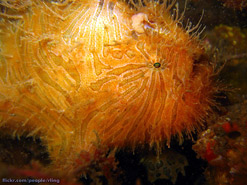Striped Anglerfish
Common Name: Striped Anglerfish
Scientific Name: Antennarius striatus

Description
The common name "anglerfish" is also used for several related families of deepwater fishes known for their angling behaviour.
The use of "anglerfish" on this page refers only to fishes in the family Antennariidae.
Size
The Striped Anglerfish grows to 20 cm in length.
Anglerfishes in general are small. The smallest, growing to 6 cm in length is the Dwarfed Frogfish Antennarius pauciradiatus, while the largest, the Roughhaw Frogfish Antennarius avalonis, grows to about 45 cm in length.
Habitats
Anglerfishes occur in many different habitats including sponge gardens, silty substrates, rocky and coral reefs. They are found from the shallow littoral zone down to the abyssal depths of the oceans.
The Striped Anglerfish is known from estuarine water less than 1 m in depth to marine waters more than 200 m deep.
Characteristics
Anglerfishes include some of the best camouflaged of all fishes. They have extraordinary adaptations including a lure for attracting their prey, a large mouth and "hidden gill openings". Striped Anglerfishes are extremely variable in form and colour, and even fish from the same area can look quite different.
Lure:
Anglerfishes attract their prey with a "fishing lure". The lure comprises a stalk - the illicium , Latin for "lure" or "inducement" and a bait - the esca. The "design" of the lure varies among genera.
In most species, the esca looks like potential prey, such as a worm, crustacean, or even a fish. The anglerfish moves the lure, mimicking the animal it is copying.
The esca of the Striped Anglerfish has between two and seven worm-like appendages (view image). When the lure is not being used it is held back against the head, as in the image above. A fish that is trying to attract prey, swings the lure forward in front of the mouth.
Large Mouth:
The Striped Anglerfish uses deception and camouflage to catch its prey. When a potential prey animal approaches, the Striped Anglerfish stays motionless with the exception of the lure. If the prey moves in to investigate the moving lure, the anglerfish rapidly opens its large mouth and sucks in its prey.
This is one of the fastest known feeding mechanism of any vertebrate animal. The whole process may happen so fast, it is impossible to see without the aid of high speed video. The large mouths and extendable stomachs of anglerfishes means they can eat very large prey.
Camouflage:
The colouration of the Striped Anglerfish is extremely variable, ranging from red, orange and yellow , through to green, brown or black. As the image on the right shows, some are heavily striped, while other Striped Anglerfish have broken stripes or spots, or lack stripes entirely.
Most anglerfishes have warts, lumps, bumps or whisker-like filaments on the body, further increasing their camouflage. Others are brightly coloured, mimicking the sponges they live among. The Sargassum Anglerfish, lives in seaweed (often Sargassum) rafts drifting in the ocean. The colouration and appendages of this species closely resembles the drifting seaweed. Juvenile Sargassum Anglerfish are sometimes found with their algal raft, floating close to the beaches of Sydney.
Hidden Gill Openings:
The small, tubular gill openings of the Striped Anglerfish are located behind and below the arm-like pectoral fins. These gill openings contract and expand rhythmically, pumping water in through the mouth and out of the gill openings. This behaviour allows the fish to appear motionless to any prey animal attracted by the movement of the lure.
In some species, this pumping action can be used to "jet-propel" the anglerfish through the water.
Number of species
Anglerfishes of the family Antennariidae are beautifully adapted predatory fishes. The family has over 40 species in 13 genera. Of these Australia has 23 species in 12 genera.
The genus Antennarius contains 24 species worldwide. The numbers of species in this family will almost certainly increase as research and collecting continues.
Location or Region Found
Antennariids occur in coastal waters around the world. The Striped Anglerfish occurs in most marine tropical and temperate waters, from shallow waters down to over 200 m. View a low resolution movie clip (71k) of a Striped Anglerfish at a depth of 123 m off Vietnam. Go to the movies page for high and low resolution versions.
In Australia, it occurs around the north of the country, from the Houtman Abrolhos Islands, Western Australia, across the north of the country, and south to Wollongong, New South Wales.
 Deep Sea Crabs
Deep Sea Crabs